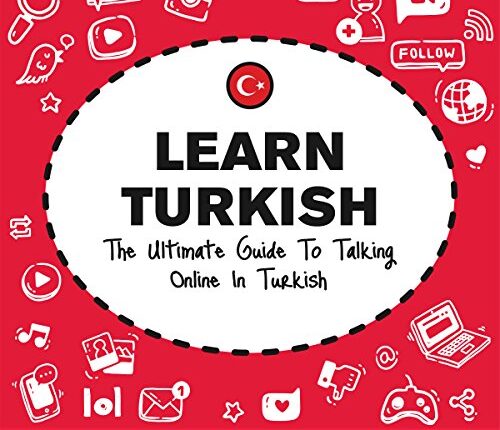Turkish language learning guide
Turkey is home to one of the oldest civilizations in human history…a country that mixes the Asian and European character because of its distinguished geographical location, which makes it a corridor to cross towards Europe..Therefore, the language of this country is special and we are all in agreement that the Turkish language has become in the past decade a biography of every tongue in the Arab world , whether because of the increase in the number of the Arab community in it, or because of its series and art, or its culture or tourist attractions.
Turkish language
These are spread, Greece, the Republic of Macedonia, Kosovo, Albania, and in a few other countries and territories in Eastern Europe. Turkish is also the mother tongue, or second language, mainly in Turkey and Northern Cyprus, and is a minority language in both Iraq for the millions of people with Turkish roots in Western Europe, particularly Germany.
The roots of the Turkish language go back to Central Asia, where inscriptions and manuscripts written in this language were found and were estimated to be about 1,300 years old.
The Turkish language spread and expanded in the west, and the number of its speakers increased with the expansion of the Ottoman Empire, especially with the settlement of a number of Turks in newly conquered Rumeli, and the Ottoman government’s adoption of its mother tongue as the official language in all administrations in various states.
In 1927, Mustafa Kemal “Ataturk”, the first president of the Turkish Republic, made several changes at the administrative and cultural level of the country, including replacing the Ottoman Turkish alphabet with the Arabic letter, with the Latin alphabet. Later, the Turkish Language Association was established with the aim of unifying the language and reorganizing it to fit the new alphabet.
An English Language Course Offered By The University Of Washington Via The Coursera Platform
Scholarship To Study German Online (Fully Funded)
Fun facts about the Turkish language
- The Turkish language belongs to the Turkic language family.
- You may notice that Turkish words are long and contain many syllables. This is due to the fact that they are classified as agglutinative languages, which means that many meanings can be expressed in one word by simply adding some letters to the word instead of using several short words, for example / maybe I will not be able to do So/ Yapamayabilirim
- The Turkish language is influenced by the Persian and Arabic languages. Among the most important Turkish words of Arabic origin are (pen – morning – time – news – right – perfect – story – minute – state – peace – workmanship – possible)
- The official Turkish Language Association was established in 1932, which would purify the Turkish language from being affected by other languages such as Arabic and Persian, whether in grammar or vocabulary, and succeeded in purifying 80% of the vocabulary and making it purely Turkish.
- It is undesirable to call someone by their first name which may be considered disrespectful You can use the titles hanımefendi (Madame) and beyefendi (Professor)
Turkish language identification card
First we will start talking about the basic information of the Turkish language:
- Number of native speakers: 83 million people.
- Number of speakers of it as a second language: 10 million people.
- Online content percentage: 2.6%
- Word count: 111 thousand Turkish words
- Writing method: alphabet, and after the revolution of the letter it became Latin
Some famous Turkish universities
Haci Tepe University, Istanbul Technical University, Middle East Technical University, Ankara University, Ege University, Gazi University, and Bilkent University.
Most popular scholarships in this language
- Ibn Khaldun Scholarships for Social Studies.
- Ali Kochcho Scholarship for Science and Technology.
- Avicenna Scholarship for Medical Sciences.
- Islamic Studies Program.
- Sports Excellence Award.
- Yunus Emre Scholarship for Turkish Language.
Resources for learning Turkish
We will start with some practical steps to learn the Turkish language
- The first step is to learn the pronunciation of Turkish letters Learn to pronounce Turkish letters.
- The second step is to understand Turkish sentence formation Turkish sentences
- The next step is to learn the most used everyday expressions the most used everyday expressions.
- The secret to mastering this language and pronouncing it like native speakers is to constantly listen to the language to familiarize your ear with sound clips in Turkish
Distinguished learning platforms
Duolingo – Digital dialects – Loecsen
Youtube channels
Learn Turkish – Edraak Academy.
Learn Turkish with Zainab Masri
Learn Turkish with Raslan Rayhan
Learn Turkish simply Öğrenme Arapça
How do I practice the Turkish language
There must be multiple sources in studying the language, and here we offer you a variety of sources to delve into the Turkish language
TV channels
ATV, CNN Turk, Kanal D
Turkish Series
Muhtesem Yüzyil – Kurtlar Vadisi – Payitaht: Abdülhamid
The most famous Turkish newspapers and magazines
Sabah _ Takvim –Hurriyet – Haber Turk – Onedio
The most famous Turkish writers
Aziz Nesin – Nâzım Hikmet Ran – Orhan Pamuk – Elif Shafak
Turkish singers
Sezen Aksu – Kenan Doğulu – Sertab Erener – Tarkan
Turkish books and novels that we recommend to read
Tutunamayanlar – Çalıkuşu – Bizim Büyük Çaresizliğimiz – Istanbul: Memories and the City – The Forty Rules of Love – Çocukluğun Soğuk Geceleri
In order to master this language, you must master the four language skills: reading, writing, listening and speaking without neglecting one of them


